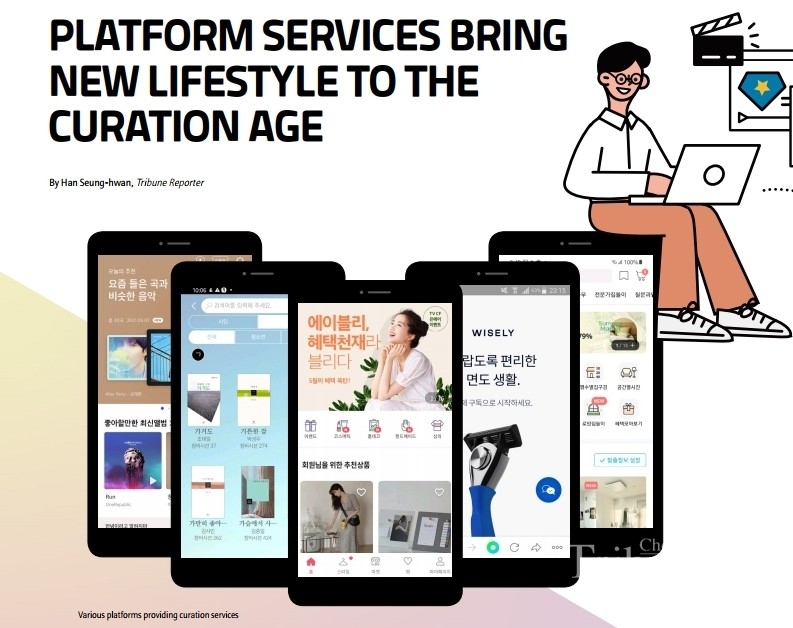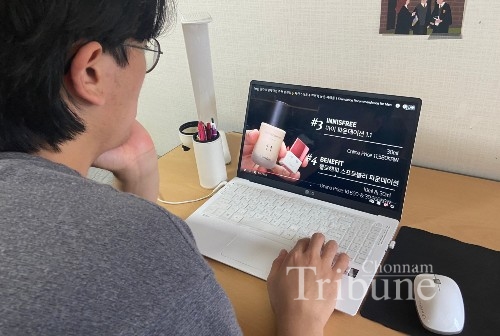
In modern society, taking time to choose just the right information for ourselves has become a stressful activity. People are getting even busier while they are being flooded with information. What if you had a personal secretary that was able to choose what you ideally wanted? From this idea, curation platform services have emerged, so users can have an experience customized to their interests and needs. Curation is a word that is derived from the word ‘curator’, someone who takes care of a collection in an art gallery or museum. It means sorting out products or content that consumers might want through technology-mediated selection and arrangement. Now many people use a variety of curation services based on their tastes and preferences. The Chonnam Tribune covered three main types of young people curating their daily life by using different curation platforms and the impact that those curation services have on the individual and society.
Subscribing to Curated Physical Goods
We are quite familiar with milk or newspaper subscription services. However, lately, many different companies have entered the subscription economy market. These companies curate goods including daily necessities for their customers and regularly deliver them, so the customers can save energy when ordering the right product for themselves. This service goes very well with the characteristics of the so-called MZ generation, which refers to millennials and Generation Z who were born in the 1980s to 2000s in pursuit of realistic convenience, reasonable prices, and diverse experiences. How did young people consider these characteristics when using subscription services?
Shaving is a very troublesome activity. “I always used to forget to buy a new razor blade for my cartridge razor. So, lately I have been using a disposable razor so that I can buy a lot at once. I would use an electric razor only if I did not have to change the blade periodically,” said Kim Hyeong-jun (Freshman, Dept. of Biology Education). To resolve this inconvenience, Wisely, a subscription platform, started a subscription service for shaving products. They deliver a new razor blade just around the time to change the blade, which reduces their customers’ inconvenience of remembering to buy a new blade every time. Tous les Jours, a bakery and café chain, started a monthly coffee subscription service. Anyone can get a cup of coffee for just 700 won every day for a month. This reasonable price attracted coffee lovers to subscribe. One of the diverse chances for the MZ generation is the pursuit of new alcoholic drinks. Sooldamhwa, an ecommerce subscription startup, delivers traditional Korean liquor every month. They curate three or four drinks every month and deliver one of them with information about how to drink it and what to eat it with. People who are tired of drinking the same alcoholic beverage but are too lazy to take the time to find new drinks find this service fascinating.

Consuming Curated Content
One of the friendliest curation services is a music streaming platform using a content-based filtering method, such as Flo or Melon. Since there is a tremendous amount of music content getting released, it is hard to find just the right music by ourselves. Furthermore, people are tired of listening to songs on the main chart and are craving new songs. So nowadays, most music streaming service apps give recommendations of playlists based on the user’s preference. They suggest songs that are similar to the songs a user has recently listened to, songs the user liked the previous year around this time, or different songs by an artist that the user listens to frequently. “A few days ago, my Flo suddenly showed me a list of songs that I had listened to a lot around this month last year. The music on the list was perfect to listen to for the current weather and atmosphere,” said Yong Do-hyeong (Sophomore, Dept. of Biology Education). This service determines not only the user’s preference, but also determines the context of the user, and suggests the songs that are perfectly adequate for a specific time and place.
There are book curation platforms like Flybook which recommend personalized books. When first starting the application, they ask about the users’ mood, interests, what genre they like, number of pages they would like to read, and how many books they read every month. Based on this information from the users, the apps offer books using the automatic curation system based on the user’s interest. This type of curation has the advantage of proposing personalized content for an individual user, it is unlikely that curation bookstores that do not have an online system can recommend books based on the taste of the customer. Automatic curation platforms seem to be the best for curation. Because of this, users can find content which matches their preference and current situation effortlessly. Meanwhile, some people said that the curation of traditional bookstores has the advantage of the exclusive point of view of the owner, a human curator, which customers find attractive. “Those little notes made by the bookstore owners about why they recommend certain books makes me look at them more carefully. It makes me wonder why the owner chose them,” said an anonymous student. Lately, people recognize the difference between human curation and AI-based curation and are interested in both types of curation. Thus, curation platforms are trying to get the appropriate balance between these types of curation in their services.
Curating Life through Social Media
It seems that curating must be done by a platform full of big data or someone extremely professional. In fact, anyone who is interested in a certain field can become a curator. ‘Swan_Beyond Grooming’ is a YouTuber who shares information about men’s beauty. Unlike the field of women’s beauty, there was not much information about men’s beauty, especially for beginners. Since he had been using make-up products, he started his YouTube channel that curates make-up products for men, tips about using those products, and tips to simply look better. After he uses several products for a while, he recommends a few of them and tells us information such as which one is adequate for a certain skin type, and the pros and cons of each product. This type of curation is based simply on his personal experience. Like him, anyone who has the courage to share their interest can become a curator.
However, some may say that the YouTuber mentioned above is an expert in men’s beauty, and it would be difficult for ordinary people to start making their own curation. Yet, curation can be done with even more trivial subjects and through a social media account. Many people post pictures of the place they visited after their trip on their social media such as Instagram and Facebook, and with the pictures, they also share what part of their trip was satisfactory and which restaurant was delicious. Also, if one of their friends asks more information about the trip in the comments, they answer with more information. Sharing common information like this could also be one type of curation. “I share my personal experiences through social media. I upload what I felt after visiting an exhibition, how I made homemade wine, and daily records of my sea-monkeys. I believe this information is necessary for someone who wants to try these things, and I will keep writing posts as detailed as I can,” said Sin Geum-cheol (Sophomore, Dept. of Chemistry Education). Sharing information is also curated content that is useful for other people to curate their lives. Curating life is not to do something special, but just sharing what you like.
Impact of the Curated Life
The MZ generation prioritizes their personal taste in consumption. Curation platforms are becoming more elaborative to provide users with customized and personalized services. Subscription services help them out by curating and delivering goods they might like to the front of their door. Content curation platforms recommend personalized content based on their preference. Even platform services that recommend the right curation platforms for users have appeared. After they find what they like through these platforms, they share their experience through social media. Anyone can curate content and their own life.
The curation platforms, however, may lead their users to get trapped inside a filter bubble, which makes them very biased. Particularly, content curation platforms using a personalized algorithm may cause serious intellectual isolation of a ‘filter bubble’ or confirmation bias to display bigotry. “Excessive use of curation platforms could limit the chance to get exposed to new information through a self-directed searching process. These people would also be surrounded by the filter bubble and unable to face the real world. They only depend on the information curated by artificial intelligence and become narrow-minded,” said Bae Ji-yang (Professor, Dept. of Communication).
The curation algorithm and filter bubbles are created based on the user’s interest and taste. Therefore, while they continue to use the curation platforms for convenience, they have to continue to keep the attitude of respecting different thoughts and make their own opinion spontaneously. Professor Bae suggests the desirable way to use curation services, “To prevent us from becoming narrow-minded, we should not only depend on the information given to us by artificial intelligence, but rather expose ourselves to a lot of different information to develop our ability to search for good information.”
By Han Seung-hwan, Tribune Reporter

